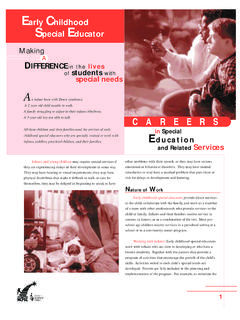Transcription of EARLY LEARNING PLACE PRESCHOOL EMERGENCY …
1 EARLY LEARNING PLACE . PRESCHOOL . EMERGENCY RESPONSE. PLAN HANDBOOK. EARLY LEARNING PLACE . PRESCHOOL . EMERGENCY RESPONSE. PLAN HANDBOOK. We have developed general operating guidelines, and procedures for a list of critical events and emergencies. This plan will not limit the use of experience, good judgment, commonsense, discretion, flexibility, and ingenuity to adapt to any type of critical event, EMERGENCY , and the complexities which exist under EMERGENCY conditions. TABLE OF CONTENTS. EMERGENCY Response Plan Page 1. EMERGENCY Communications ..Page 1. Goals ..Page 1. Scope ..Page 2. Evacuation Locations ..Page 2. On Site Evacuation ..Page 2. Safe Room ..Page 2. Lockdown and Hide Page 3. Fire Evacuation Page 4. Off-Site Evacuation ..Page 4. Off-Site Remote Location .Page 5. Family Reunification .. Page 6. Bomb Threat . Page 6. Bomb Threat Checklist ..Page 8. Intruder/Hostage ..Page 9. Utility Loss or Failure . Page 10. Medical EMERGENCY Page 11. Pandemics .Page 11.
2 Terrorism ..Page 12. EMERGENCY Phone Numbers .Page 12. Site Plan Utility ..Page 13. Site Plan Exits .Page 14. Signature Page .. Page 15. EMERGENCY RESPONSE PLAN. This plan defines EMERGENCY response operations such as communications plans, student release procedures, general EMERGENCY actions, and hazard-specific procedures. This plan will be reviewed by all PRESCHOOL staff annually. EMERGENCY COMMUNICATIONS. If an EMERGENCY occurs during PRESCHOOL hours: Do not drive to the school unless it is safe to do so and/or you have been directed by the PRESCHOOL director to pick up your child. It may be difficult to get through to the PRESCHOOL via telephone because of damage to phone lines or cell phone tower outage. Staff will contact parents as soon as possible. Tune to news media for EMERGENCY instructions. In times of EMERGENCY , information about the status of schools is communicated through a variety of media. The PRESCHOOL requests that parents do not call their child's school or the church office in times of EMERGENCY as it is important to keep phone lines free for EMERGENCY communications.
3 Circumstances may prevent parents from picking up their children or may require that children be picked up at a location other than the PRESCHOOL facility. The safety of children and staff is our first priority. Our second priority is the reunification of parents with their children. Parents should check the following sources for information and status reports: Local media The PRESCHOOL website: In times of EMERGENCY , general information will be shared with the community through major radio and television stations: The staff of the EARLY LEARNING PLACE PRESCHOOL will strive to preserve and protect life, reduce emotional trauma, minimize personal injury, and cooperate with the local EMERGENCY preparedness agencies. GOALS. The primary goals of this plan are to: Develop effective crisis and security plans that will promote the safety and welfare of students and PRESCHOOL staff, protect PRESCHOOL property, and regulate the operation of the PRESCHOOL during a crisis incident, critical incident, or medical EMERGENCY .
4 Prepare students and PRESCHOOL staff to take appropriate actions in response to natural, technological, or PRESCHOOL specific hazards. Provide parents with accessibility to the policies, guidelines and procedures we will be utilizing during an EMERGENCY . 1. SCOPE. For purposes of this EMERGENCY Preparedness Plan, PRESCHOOL crises are organized into two categories: critical incident and medical emergencies. Critical incidents are events requiring an immediate response by public safety agencies and are managed by the PRESCHOOL staff only until public safety officials arrive. They are not limited to natural and technological disasters, or security emergencies that adversely affect the normal operation of the PRESCHOOL . Examples include: tornadoes, hurricanes, flooding, severe thunderstorms/weather incidents, terrorist attacks, fire, hazardous material spills, situations involving a hostage or kidnapping, threats involving weapons, explosions, and fugitive or suspect being pursued near the PRESCHOOL by law enforcement.
5 Medical emergencies are those possible life threatening situations arising from health conditions as well as unintentional injuries. Examples include cardiac arrest, serious illness or condition, seizure, playground accidents, and acts of violence that require EMERGENCY medical treatment. PRESCHOOL staff and local EMERGENCY medical personnel have primary responsibilities in responding to medical emergencies. Acts of violence will also require law enforcement involvement. A crisis incident, critical incident or medical EMERGENCY can vary in scope and intensity. Situations can range from a non- EMERGENCY school crisis involving a single student to a life threatening situation affecting the entire PRESCHOOL . EVACUATION LOCATIONS. On-site Evacuation There are several causes for evacuation utilized by the PRESCHOOL . Safe Room One is the typical on-site evacuation to a Safe Room, where students and staff are evacuated from their classrooms to a central Safe Room location in the PRESCHOOL facility.
6 Safe rooms are located in areas of the building that maximize the safety of occupants. A Safe Room is used when evacuation would PLACE students at risk. Safe Rooms may change depending on the necessity and EMERGENCY conditions. The most common on-site evacuation would be in response to a tornado warning, structural hazard, or severe outside environmental hazard, outside gang activity. Our designated Safe Rooms are located across from the Director's Office. Safe Room Procedures PRESCHOOL Director Order a Safe Room Evacuation for students inside and outside the facility. Communication will be by cell phone, word of mouth, or intercom If warranted, the Director would shut off heating, ventilation and air conditioning to stop inflow of outside air into the building. 2. Teachers Immediately move to Safe Room (if it is safe to do so) using the closest route to Safe Room Teachers will take attendance and account for all students. Report any missing students to the Director.
7 Be prepared to announce a change in status (drop, cover and hold). If necessary PLACE towels along the bottom of doors No students or staff are allowed outside the building. Close and lock all exterior doors and windows. Monitor the main entries until the All Clear is given. Lock Down and Hide When there is a threat of violence or serious incident that could jeopardize the safety of students/staff including intruders, shootings, hostage incidents, gang violence or civil disturbance. The staff will lock the doors and PLACE children in the safest PLACE possible in their classrooms or the nearest safe room that can be locked. Lockdown and Hide drills are practiced monthly. Lockdown and Hide Procedures PRESCHOOL Director The PRESCHOOL Director or designee will make the following announcement using the building intercom, cell phones or runners: Your Attention, Please. We are in Lockdown and Hide EMERGENCY and you must lockdown and hide immediately. Teachers lock your doors and move children to a safe PLACE inside your classroom.
8 Ignore all alarms and bells unless advised otherwise. Stay quiet and as still as possible, use furniture to hide under or behind.. Notify staff and classes outside to immediately move to Lockdown and Hide, Account for the students by making sure teachers have classroom rosters and EMERGENCY backpacks Director or designated staff will call 9-1-1, identify the name and address of the PRESCHOOL , describe the EMERGENCY , state the school is locking down, provide intruder description and weapon(s) if known, and identify the location of the PRESCHOOL Close and lock all doors possible Teachers Clear the hallway and bathrooms by your room moving everyone into the classroom Lock your doors, turn off your lights, and shut your blinds and windows Move students and staff away from the doors and windows. Have all persons sit down against an interior wall or position behind furniture Ignore all bells and alarms unless otherwise instructed. (intruders often set off alarms). Take attendance and be prepared to notify the PRESCHOOL Director of missing students or additional students, staff or guests sheltered in your classroom.
9 Allow no one outside of the classroom until the PRESCHOOL Director gives the All Clear signal. 3. Lockdown/Get Out If an immediate life threatening situation exists, exit immediately to a PLACE of safety when possible Fire Evacuation is when staff and students are moved out of the PRESCHOOL facility to a safe location outside the building. Students are directed to leave the building and assemble at a designated site outside the facility. Fire Drill designated locations are along the back fence line of the parking lot in the back of the church. Procedures for Fire Evacuation Activate fire alarm or otherwise alert staff that there is a fire by use intercom, cell phones, intercom Evacuate the building quickly and calmly Take attendance sheets and EMERGENCY If caught in smoke, have everyone drop to hands and knees and crawl to exit. Pull clothing over nose and mouth to use as a filter for breathing. If clothes catch fire, STOP, DROP, & ROLL until fire is out. If necessary, have staff person check areas where children may be located or hiding before leaving building.
10 Report any missing children to the Director immediately Gather in designated meeting PLACE outside and account for all children and staff Call 911 from outside of building. Do not re-enter building until cleared by fire department. Fire Drills are practiced twice monthly Evacuation to Off-Site Locations We would move children to off-site evacuation site, as a result of a natural disaster or facility hazard, or bomb threat in which the PRESCHOOL building is damaged or considered unsafe The staff and students would need to immediately relocate to a different building. In this case, the children are escorted across the field to the Church of Latter Day Saints 5001 Altamesa Blvd, Fort Worth, TX 76133. Children and Staff will walk to this location across the open field to the church, and remain there until the All Clear is declared , or until Parent Reunification has been organized and parents have been notified when and where to pick up children. 4. Off-Site Evacuation to a Remote Location In case of complete area evacuation due to toxic spill, explosion or gas leak, children would be moved by the Fire Department to Edgepark Methodist Church, 5616 Crowley Road, Fort Worth, Texas, 76134.







